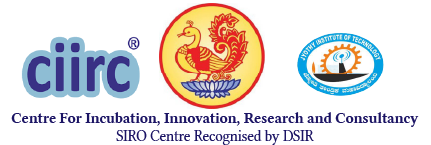Overview
Nanoscience and Engineering laboratory mainly focuses on thrust areas of research such as supercapacitors, heterogeneous catalysis and thermal interface materials. Nanocomposites of multiwalled carbon nanotubes with transition metal/s and metal oxide/hydroxides are synthesized by wet chemical process and utilized efficiently as electrode material in supercapacitors, catalysts supports for synthesis of fine chemicals and thermal interface materials.

Supercapacitors
Nanocomposites of oxides/hydroxides of Mn, Ni, Co, Ru and mixed metal oxides/Ni, Co and Ni/Co metal organic frameworks (MOFs) with acid functionalized multiwalled carbon nanotubes (MWCNTs) and activated carbons, derived from biowaste materials like banana stem, pigeon pea stem, Pongamia pinnata seed oil extract cake & milkweed, have all been developed as positive and negative electrode materials respectively for hybrid supercapacitors. The synthesized electrode materials, studied for high performance supercapacitors, are subjected to predictive and validation process via DFT (Density Functional Theory) and Machine learning approach to design an efficient hybrid supercapacitor materials. Asymmetric and symmetric coin cells have been fabricated in the lab and tested for their supercapacitance performance. Low cost, ecofriendly, easily and abundantly available biowaste have been efficiently converted into activated carbon and used in the fabrication of coin cells which have proven to be high-performance supercapacitors with practical applications.

Flexible Solid-state Supercapacitors
Flexible solid-state supercapacitors (SCs) are of considerable interest as mobile power supply for future flexible electronics because they can provide substantially higher specific/volumetric Energy density compared to conventional capacitors. Additionally, flexible solid-state SCs are typically small in size, highly reliable, light-weight, easy to handle, and have a wide range of operating temperatures. In this regard, solid-state SCs hold great promise as new energy storage devices for flexible and wearable electronics compared to SCs using liquid electrolytes. Especially, mixed metal oxides of Ni, Co & Mn with MWCNTs nanocomposites have been narrowed down for fabrication of flexible solid state supercapacitors.
Heterogeneous Catalysis
Development of solid, acid–base or redox catalysts for organic transformations or synthesis of organic fine chemicals under environmentally benign conditions is one of the active fields of research in heterogeneous catalysis. A number of bulk and fine chemicals are manufactured using heterogeneous catalysts such as metals, metal oxides, zeolites, clays, etc. Metals/metal oxides are used either in their native form or, very often, supported on an inert material. Currently, carbon nanotubes and mesoporous carbon are being developed as new environmental benign supports for solid supported catalysts, especially in transition metal oxide/s composites, and are applied in the synthesis of organic fine chemicals via amidation, hydrogenation, esterification and transesterification. Organic fine chemicals are derived from these reactions and are industrially important. They find applicationin polymer, agrochemicals, cosmetics and pharmaceutical industries.

Thermal Interface Materials
Nanofluids of MWCNTs with transition metals /metal oxides and appropriate base fluids have been developed in the lab as thermal interface materials. These materials are inserted between heat producing and heat dissipating devices (heat sink) for efficient heat transfer. The enhanced heat transfer observed is due to unique properties of nanoparticles dispersed in the base fluids. Further, these nanofluids were effectively used in LEDs, electronic cooling systems and heat exchangers.
- A correlation of surface/textural properties of carbon derived from Musa acuminata stem and its high supercapacitance performance with superior cycle stability. Gopalakrishna Byatarayappa, Radhika M G, Umananda M. Bhatta, Deepak V. Ingale, Krishna Venkatesh, Nagaraju N, Kathyayini N, Journal of Energy Storage 44 (2021) 103424.IF: 6.583
- Superior cycle stability performance of a symmetric coin cell fabricated using KOH activated biochar derived from Cajanus cajan stems.Gopalakrishna Byatarayappa, Vijaykumar Guna, Krishna Venkatesh, Narendra Reddy, Nagaraju. N, Kathyayini Nagaraju, Journal of Environmental Chemical Engineering 9 (2021) 106525. IF:5.909
- Green carbon with hierarchical three dimensional porous structure derived from – Pongamia pinnata seed oil extract cake and NiCo2O4-Ni(OH)2/Multiwall carbon nanotubes nanocomposite as electrode materials for high performance asymmetric supercapacitors. Chaitra, Reddy Narendra, Krishna Venkatesh, N. Nagaraju, Nagaraju Kathyayini, Journal of Power Sources(2017) 356:212-222.IF:9.127
- KOH activated honeycomb like turbostratic porous carbon derived from banana fibres as an efficient negative electrode in high performance asymmetric supercapacitor. Chaitra K, Vinny R T Sivaraman P, Narendra Reddy, Krishna Venkatesh, Vivek C S, Nagaraju N, Kathyayini N. Journal of Energy Chemistry(2016) 26:56-62.IF:9.676
- Environmentally benign selective hydrogenation of α, β-unsaturated aldehydes and reduction of aromatic nitro-compounds using Cu based bimetallic nanoparticles supported on multiwalled carbon nanotubes and mesoporous carbon. Hareesh H. N, Minchitha K. U, Nagaraju N, Kathyayini N, RSC Advances(2016)6:82359-82369. IF: 3.361
- Design of Sulphate Modified Solid Acid Catalysts for Transesterification of Diethyl Malonate with Benzyl Alcohol.Hareesh H. N, Minchitha K. U, Nagaraju N, Kathyayini N.Journal of Nanoscience and Nanotechnology(2018)18(1) 202-214.IF:1.4
Electrochemical workstation-Potentiostat- Galvanostat (CHI660E)
- Brunauer–Emmett–Teller (BET) Surface Area Analyzer
- Coin Cell Crimping Machine
- Fume Hood
- Muffle Furnace
- Ultrasonicator
- Centrifuge Machine
- VacuumOven
- Hot Air Oven
- Rotary Evaporator
- Weighing Balance
- Soxhlet Extraction
- Magnetic Stirrers
- Oil Bath with Stirrer

Development of Ni/Co/Mn/MWCNTs based Nanocomposites as Positive Electrode and Low cost ‘Green’ Carbon obtained from Bio-wastes as Negative Electrode Materials for Hybrid Supercapacitors” on supercapacitors for designing coin cells, sanctioned by MATERIALS FOR ENERGY STORAGE (MES) – DST

Kathyayini N
Kathyayini Nagaraju currently works as a Professor at the Centre. An alumnus of Bangalore University, she obtained her M.Sc. and Ph.D. in Chemistry in1994 and 2009 respectively. She has 20 years of research and teaching experience from reputed institutes. She undertook part of her doctoral work at the NMR unit of Namur University, Namur, Belgium, and worked on “Production, Characterization and Functionalization of Multiwalled Carbon Nanotubes”. She has published more than 45 research papers in peer reviewed national and international journals. She has received Achievement Award from JU in 2015 for publishing research articles in high impact factor journals. She also has received several BEST PAPER awards in national and international conferences. She is a reviewer for international journals such as Journal of Material Science and Australian Journal of Chemistry.
Kathyayini’s research interests are focused on the preparation and characterization of composites of Multiwalled carbon nanotubes with transition metal oxides and their applications in super capacitors and in the synthesis of organic fine chemicals via heterogeneous catalysis. She has received project funds to the tune of Rs. 100.0 lakhs from different government funding agencies like DST-MES, NRB and NP-MICAV to carry out research in the area of heterogeneous catalysis and super capacitors. She is a member of American Chemical Society, The Electrochemical Society of India, The Luminescence Society of India and Indian Society for Technical Education. She has been guiding several B.E and M.Tech. students’ projects in the field of Nanotechnology. She has guided four Ph.D. students; five others are currently working for their doctoral degree from JU and VTU in the areas of heterogeneous catalysis /supercapacitors.

Minchitha K U
Dr. Minchitha obtained her Master degree in Industrial Chemistry from Kuvempu University during 2008-2010. She received her Ph.D in the field of heterogeneous catalysis from Jain University in 2016. Minchitha has about eleven years of research experience and published fourteen research articles in peer reviewed International and National journals. She has also presented her findings in International and National conferences. She has received outstanding researcher award from Jain University in 2012. She has also received best paper award from Jain University in 2015. She is a member of catalysis society of India. She has guided several M.Sc., student projects in the field of catalysis. Her areas of interest include applications of Multiwalled carbon nanotubes in catalysis and water purification. Minchitha is currently working as an Assistant Professor at the Centre.
Email Id: minchitha.ku@ciirc.jyothyit.ac.in

Gopalakrishna B
Gopalakrishna B received his Master’s degree in inorganic chemistry from Bangalore University in 2017. He has one year teaching experience as Assistant Professorat V.V Puram College of Science. He is currently working on hybrid supercapacitors under a DST-MES funded project. He has published six research articles in peer reviewed journals and presented three papers in international conferences.
